Peter Janssen, a painter who, during his lifetime was very active and
productive, has left a big legacy. We as his descendants have decided to introduce his great work
to the public and make it available for the world-wide community of the
Internet.
Peter Janssen comes from a family with a long artistic tradition, therefore
it is necessary to go back a little in history.
|
It is now almost 200 years since this development started in 1816.
Tamme Weyert
Theodor Janssen, a farmers’ son was born in the German village of
Jübberde. He left his home for Düsseldorf, furnished with a scholarship
of the local County Bank, to start his studies as a painter at the Royal
Prussian Academy of Arts. |
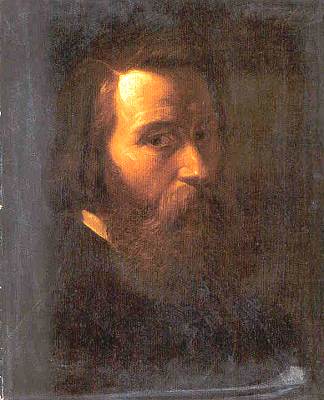 |
His parents were very supportive of his ambitions as an artist and already
early on in his life had him trained by the portrait painter Dieckmann in
Leer.
Arriving in Düsseldorf, Theodor Jannsen proceeded to the Academy
Director, Wilhelm Schadow and asked to be registered for his studies.
Theodor Janssen made himself a name as engraver of famous paintings: To
which the historical paintings of Carl Friedrich Lessing and the Genre paintings
of Johann Peter Hasenclever, especially his famous cycle of paintings for
the “Jobsiade” belonged.
Close friendships as they widely existed among the artists of the
Düsseldorf Academy of Arts, of which the numerous paintings of friendship
give account, Theodor Janssen also joined the Düsseldorf Artists
Association “ Der Malkasten”, together with the still life painter
Johann Wilhelm Preyer (1803-1889) and Johann Peter Hasenclever (1810-1053),
who also painted the portrait of Theodor Janssen, which is owned by “
Der Malkasten” to whose founding members both artists belonged.
Theodor Janssen was also accepted as a portrait engraver outside
Düsseldorf. His ability in this respect can be seen in the portrait
of the poet Ferdinand von Freiligrath, a hand signed pen-drawing, which is
also preserved in the Stadtmuseum.
In 1867 Theodor Janssen gave up his occupation as a copper engraver and
became a teacher for drawing at the Düsseldorf Luisen School. Almost
blind he died in 1894.
|
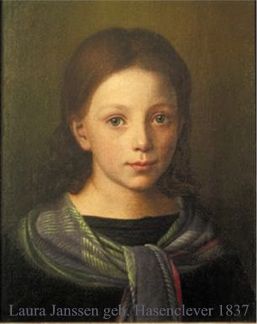 |
That the children of Theodor and Laura Janssen
inherited excellent artistic
genes is not surprising.
Three of their sons, Peter born in 1844,
Theodor
born in 1846 and Karl born in 1855 decided on
artistic careers. |
|
|
|
|
|
Lets start with Peter the eldest son, who already at the age of 15 started
his education as a painter at the Düsseldorf Academy of Arts and there
was the student of Carl Müller, Carl Sohn and Eduard Bendemann. |
 |
In 1869
came his breakthrough as a history painter with
the wall paintings in the Town Hall of Krefeld, showing scenes of the life
of Hermann the Cherusker.
In 1895 he reached the peak of his academic career being named Director
of the Academy of Arts in Düsseldorf.
|
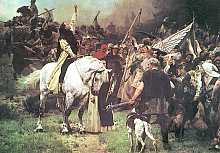 |
Düsseldorf’s history was a theme of a monumental
canvas painting
for Peter Janssen. In 1893 he
created a painting showing the Battle of Worringen
which can be considered as a City-Foundation-Painting,
because after
this battle the greatful Count
Adolf V. von Berg awarded the people of
Düsseldorf
the City Rights August 14th 1288. Matching its
historical
meaning, the painting which belongs
to the Stadtmuseum is displayed at the
Düsseldorf
Town Hall in the Jan Wellem Salon. |
Peter’s brother Theodor was born in 1846 and died already in 1886. Unfortunately little is
known about him. He became an architect and at the same time was professor at
the school for art handycrafts. Karl Janssen born in
1855 on the other hand is still present through his work in Düsseldorf.
He joined the Düsseldorf Academy of Arts in 1873 as student of Professor
August Wittig’s sculpting class. Several years of studies in Rome made
him familiar with the Antique Art as well as the Roman Barock, two styles
which he incorporated in his work in a historical manner.
Karl Janssen’s career as a sculptor is closely connected with the
historic artistic development at the Düsseldorf Academy of Arts. A sculpting
class was established only in 1862. In the founding years, when Karl Janssen
began his studies there was an increasing demand in sculptures by wealthy
citizens and industrialists - be it for their parks and villas or even their
grave-sites. One of the earlier and most moody creations is his mausoleum
for the Düsseldorf’ industrialist Albert Poensgen (died in 1880)
created in 1883 at the Düsseldorf’ Northern Cemetery.
In 1884 he created together with the sculptor Joseph Tüshaus the
fountain-sculpture
“Father
Rhine and his Daughters” which was meant for the Emperors celebrations
and which cast in bronze is standing in front of the Stateparliament
(Landtag).
His major creation was the also preserved sculpture on horseback of William
I. (1889).
Finally also Karl Janssen went for an academic career. After the death
of August Wittig he was appointed Professor for sculpting at the Düsseldorf
Academy of Arts.
His daughter Gerda married the Düsseldorf’ industrialist Dr.
Hugo Henkel in 1908.
The Henkel family ordered several paintings among others the mausoleum
of the Henkel family designed in 1925 at the Düsseldorf’ northern
cemetery. It was the major part of his neo-classisistic period. The unsigned
bust of Academy Director Peter Janssen is considered a creation by Karl Janssen.
Karl Janssen died in 1927.
The eldest son of Academy Director Peter Janssen, born in 1874, also named
Peter did not continue the line of artists in this family. After studying
medicin he practised at the Medical Academy, the predecessor of the
Düsseldorf University. In 1904 the young doctor married Martha Leiffmann
As Secret Commercial Advisor and Banker as well as deputy to the town council,
her father Moritz Leiffmann enjoyed an excellent reputation. Shortly
after the First World War Peter Janssen was appointed Professor. As surgeon
and urologist he was a sought capacity in his field. In 1926 he initiated
the foundation of the Golzheimer Clinic, whose chief he remained until his
death.
|
|
The artistic talent of his first son Peter born in 1906 was obvious very
early. His desire to become a painter and therefore continuing the
family tradition, was met with a lot of understanding and very possitive support,
which only seems normal in such an art minded environment.
|
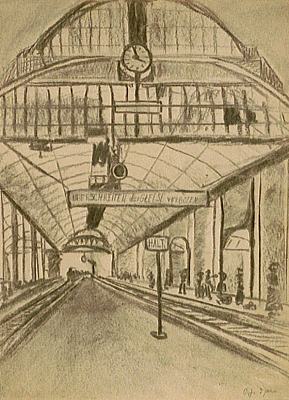 |
|
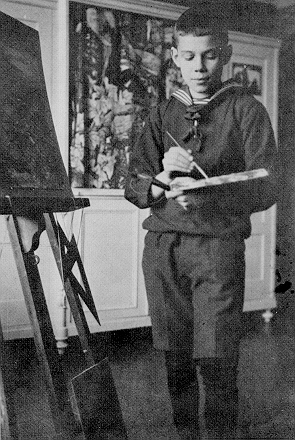 |
Already
at the age of 12 Peter Janssen was posing
in front of
an easel for a photographer in the typical,
sailor’s outfit
fashionable at the time. |
His development was hampered dramatically due to his “non arian
descent” - the father of his mother and the mother of his father belonged
to the Jewish community but converted to Protestantism prior to the relevant
marriages - when based on the Reichskammerkulturgesetzes of 01.11.1933 he
was prohibited to practise as painter graphic designer. In 1944 he
was deported into a concentration camp from which he luckily escaped after
5 months..
His life led him to Berlin in 1957, where he taught as professor at the
Academy of Fine Arts.
In 1979 he died in Berlin.